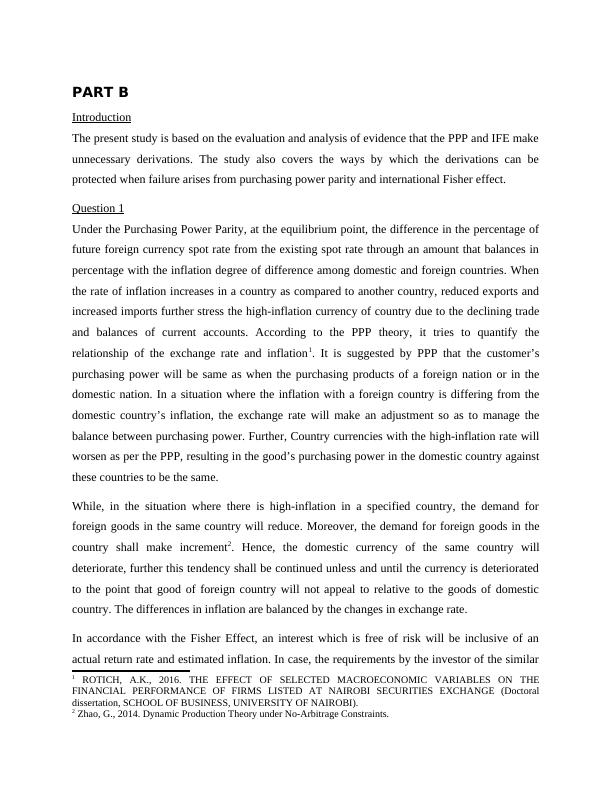PPP and IFE in International Financial Management
Added on 2023-06-12
9 Pages2901 Words202 Views
International financial management

Table of Contents
Part B...............................................................................................................................................3
Introduction..................................................................................................................................3
Question 1....................................................................................................................................3
Question 2....................................................................................................................................5
Conclusion...................................................................................................................................8
Bibliography....................................................................................................................................9
Part B...............................................................................................................................................3
Introduction..................................................................................................................................3
Question 1....................................................................................................................................3
Question 2....................................................................................................................................5
Conclusion...................................................................................................................................8
Bibliography....................................................................................................................................9

PART B
Introduction
The present study is based on the evaluation and analysis of evidence that the PPP and IFE make
unnecessary derivations. The study also covers the ways by which the derivations can be
protected when failure arises from purchasing power parity and international Fisher effect.
Question 1
Under the Purchasing Power Parity, at the equilibrium point, the difference in the percentage of
future foreign currency spot rate from the existing spot rate through an amount that balances in
percentage with the inflation degree of difference among domestic and foreign countries. When
the rate of inflation increases in a country as compared to another country, reduced exports and
increased imports further stress the high-inflation currency of country due to the declining trade
and balances of current accounts. According to the PPP theory, it tries to quantify the
relationship of the exchange rate and inflation1. It is suggested by PPP that the customer’s
purchasing power will be same as when the purchasing products of a foreign nation or in the
domestic nation. In a situation where the inflation with a foreign country is differing from the
domestic country’s inflation, the exchange rate will make an adjustment so as to manage the
balance between purchasing power. Further, Country currencies with the high-inflation rate will
worsen as per the PPP, resulting in the good’s purchasing power in the domestic country against
these countries to be the same.
While, in the situation where there is high-inflation in a specified country, the demand for
foreign goods in the same country will reduce. Moreover, the demand for foreign goods in the
country shall make increment2. Hence, the domestic currency of the same country will
deteriorate, further this tendency shall be continued unless and until the currency is deteriorated
to the point that good of foreign country will not appeal to relative to the goods of domestic
country. The differences in inflation are balanced by the changes in exchange rate.
In accordance with the Fisher Effect, an interest which is free of risk will be inclusive of an
actual return rate and estimated inflation. In case, the requirements by the investor of the similar
1 ROTICH, A.K., 2016. THE EFFECT OF SELECTED MACROECONOMIC VARIABLES ON THE
FINANCIAL PERFORMANCE OF FIRMS LISTED AT NAIROBI SECURITIES EXCHANGE (Doctoral
dissertation, SCHOOL OF BUSINESS, UNIVERSITY OF NAIROBI).
2 Zhao, G., 2014. Dynamic Production Theory under No-Arbitrage Constraints.
Introduction
The present study is based on the evaluation and analysis of evidence that the PPP and IFE make
unnecessary derivations. The study also covers the ways by which the derivations can be
protected when failure arises from purchasing power parity and international Fisher effect.
Question 1
Under the Purchasing Power Parity, at the equilibrium point, the difference in the percentage of
future foreign currency spot rate from the existing spot rate through an amount that balances in
percentage with the inflation degree of difference among domestic and foreign countries. When
the rate of inflation increases in a country as compared to another country, reduced exports and
increased imports further stress the high-inflation currency of country due to the declining trade
and balances of current accounts. According to the PPP theory, it tries to quantify the
relationship of the exchange rate and inflation1. It is suggested by PPP that the customer’s
purchasing power will be same as when the purchasing products of a foreign nation or in the
domestic nation. In a situation where the inflation with a foreign country is differing from the
domestic country’s inflation, the exchange rate will make an adjustment so as to manage the
balance between purchasing power. Further, Country currencies with the high-inflation rate will
worsen as per the PPP, resulting in the good’s purchasing power in the domestic country against
these countries to be the same.
While, in the situation where there is high-inflation in a specified country, the demand for
foreign goods in the same country will reduce. Moreover, the demand for foreign goods in the
country shall make increment2. Hence, the domestic currency of the same country will
deteriorate, further this tendency shall be continued unless and until the currency is deteriorated
to the point that good of foreign country will not appeal to relative to the goods of domestic
country. The differences in inflation are balanced by the changes in exchange rate.
In accordance with the Fisher Effect, an interest which is free of risk will be inclusive of an
actual return rate and estimated inflation. In case, the requirements by the investor of the similar
1 ROTICH, A.K., 2016. THE EFFECT OF SELECTED MACROECONOMIC VARIABLES ON THE
FINANCIAL PERFORMANCE OF FIRMS LISTED AT NAIROBI SECURITIES EXCHANGE (Doctoral
dissertation, SCHOOL OF BUSINESS, UNIVERSITY OF NAIROBI).
2 Zhao, G., 2014. Dynamic Production Theory under No-Arbitrage Constraints.

End of preview
Want to access all the pages? Upload your documents or become a member.
Related Documents
Theory of Purchasing Power Parity (PPPT)lg...
|11
|2671
|235
Study of PPP, IFE, IRPlg...
|73
|17574
|278
MGMT2023 - Assignment on International Finance Managementlg...
|16
|4538
|74
Justification of Volatility of Foreign Exchange Rates given PPP and UIPlg...
|10
|2247
|95
The International Financelg...
|13
|2586
|14
International Financial Management: Purchasing Power Parity and Foreign Exchange Risklg...
|18
|3632
|118
